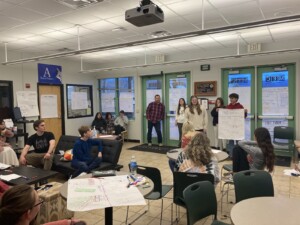Meet the Culture Hackers: Microcredentials Aren’t Just for Students

By: Robert Thornton
How We Started with Microcredentials & Career Pathways
When Harmony Public Schools (Harmony) received a Race to the Top grant in 2012, a lot of expectations changed across the system. As student-centered models for instruction took hold, teachers demanded higher quality professional learning experiences and requested more academic leadership from their administration including more collaboration with their colleagues. The competency-based approach to professional learning by awarding microcredentials on completion reinforces the skill-sets that Harmony believes are critical to success across a variety of roles within our system.
Ultimately, in order to play a part in the success of students within Harmony, we must all be willing to engage job-embedded learning experiences related to our roles. With microcredentials, our educators know they will be encouraged to implement new learning within their practice in a way that is aligned to their aspirations as a professional.  When administrators use the idea of career pathways to coach teachers on their campus they are providing the learning experience they expect their teachers to provide to their students. Before any microcredential work can begin, the administrator must learn about the teacher:
When administrators use the idea of career pathways to coach teachers on their campus they are providing the learning experience they expect their teachers to provide to their students. Before any microcredential work can begin, the administrator must learn about the teacher:
- How much experience do they have?
- How confident are they as instructors?
- Do they want to stay in the classroom and lead teachers?
- Do they enjoy working with curriculum and assessments?
- Do they want to leave the classroom and enter administration?
Based on what they learn from the teacher, they can match their short- or long-term aspirations to specific options for professional learning, all while the teacher stays engaged in their classroom or program.
Developing Microcredential Tracks
Whenever possible, we begin with an existing job description or work with our senior leadership to develop a clear role for a teacher to aspire to, taking into consideration current and near future system-wide programs within our school system. In some cases, our programs are developed around initiatives such as Teach Like a Champion or Instructional Coaching. From there, our partners at Bloomboard guide a small group of central leadership and current role holders through a process that results in a list of competencies and descriptions. This process continues via task design, rubric creation, and support resources. We really enjoy being involved at each point in the process to ensure that Harmony values and resources are continually embedded within a product designed to meet the rigorous expectations of a Bloomboard microcredential. Sometimes we decide to make changes to existing microcredentials based on trends in participant submissions brought to us by Bloomboard or develop support mechanisms based on overall program data.
We really enjoy being involved at each point in the process to ensure that Harmony values and resources are continually embedded within a product designed to meet the rigorous expectations of a Bloomboard microcredential. Sometimes we decide to make changes to existing microcredentials based on trends in participant submissions brought to us by Bloomboard or develop support mechanisms based on overall program data.
Recently, Bloomboard created a microsite to help Harmony broadly communicate information around microcredentials to educators across our system. There are also several internal documents that administrators, support staff, or teachers themselves can leverage in order to engage in the program.  When a teacher logs in to review microcredential tracks, they will see clickable graphics where teachers can directly engage with microcredential and overall program information. At the core of the experience is the Bloomboard platform and Bloomboard’s reputation for timely support requests. Harmony educators submit all of their artifacts of learning and receive feedback on their submission via the Bloomboard platform. Our administration is able to generate reports in order to target specific educator populations across our vast school system.
When a teacher logs in to review microcredential tracks, they will see clickable graphics where teachers can directly engage with microcredential and overall program information. At the core of the experience is the Bloomboard platform and Bloomboard’s reputation for timely support requests. Harmony educators submit all of their artifacts of learning and receive feedback on their submission via the Bloomboard platform. Our administration is able to generate reports in order to target specific educator populations across our vast school system.
Adjustments
For all our planning, we’ve still encountered a couple snags to smooth out. And they’re somewhat predictable whenever trying to change your professional learning culture:
- When we lost some early momentum. Early on, there was a lot of program information delivered directly to teachers. This generated a lot of excitement among teachers that did not resonate with administrators because the way they supported teachers also had to be changed for this culture shift, which led to the next adjustment.
- When leadership recognized the need to offer school administrator tracks as well. With teaching and learning supports in place, and the former administrator’s responsibilities for observations evolving, it was just a matter of time before the school leaders needed to learn new skills for their leadership roles. Administrator microcredential tracks were the solution, especially for those moving into education leadership from the classroom.
- When it became ‘one more thing.’ There was a lot of effort put into defining microcredentials and making sure everyone understood the process. The problem was that all of these programs aligned to existing roles that full-time employees hold so earning a microcredential was viewed as ‘one more thing’ by many people. Over time, we have been able to coordinate professional learning, evaluation, and role support that in the best cases, seamlessly weaves in microcredentials.
The key to implementing a microcredential program like Harmony has accomplished is to recognize the inherent competing interests as the days keep moving forward, that each teacher has their learners to prioritize before tending to their own growth. But they have to. And at Harmony, we’re helping teachers prioritize their own needs and put time into their schedules so they can be even more effective with those students. It has positively impacted our professional learning culture and will continue to do so in times like we’re currently facing as we all look for new ways to keep learning continuous for all at Harmony.
Additional Resources:
- Harmony Public Schools Microcredential Initiative
- Harmony Public Schools Career Pathways through Micro-credentials
- Designing a Rigorous Microcredential Assessment Process
- Competency-Based PD: A Recipe for Educator Success
This post is part two of a five blog series in the upcoming “Getting Smart on Competency-Based Career Advancement at Harmony Public Schools” produced in partnership with Harmony Public Schools (@HarmonyEdu).
For more, see:
- Back to School with Harmony
- Getting Smart on Learner-Centered STEM
- Learner-Centered STEM: Meet Harmony Public Schools
Robert Thornton is a curriculum director and grant facilitator for Harmony Public Schools. Follow him on Twitter at @YNWAThornton.
Stay in-the-know with innovations in learning by signing up for the weekly Smart Update.







0 Comments
Leave a Comment
Your email address will not be published. All fields are required.